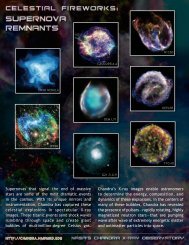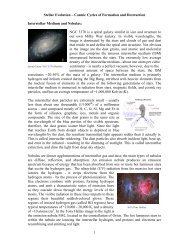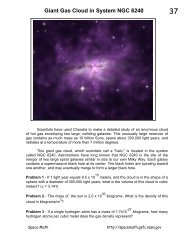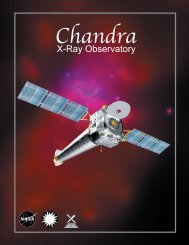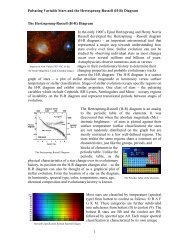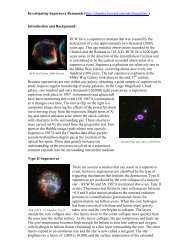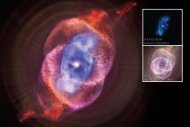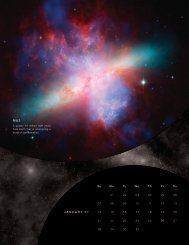Full 17x11" Calendar, High Resolution - Chandra X-ray Observatory
Full 17x11" Calendar, High Resolution - Chandra X-ray Observatory
Full 17x11" Calendar, High Resolution - Chandra X-ray Observatory
Create successful ePaper yourself
Turn your PDF publications into a flip-book with our unique Google optimized e-Paper software.
El Gordo<br />
This young galaxy cluster, nicknamed “El Gordo” for<br />
the “big” or “fat” one in Spanish, is a remarkable object.<br />
Found about 7.2 billion light years away, El Gordo appears<br />
to be the most massive, hottest, and most powerful<br />
X-<strong>ray</strong> emitter of any known cluster at its distance<br />
or beyond. In this composite image, X-<strong>ray</strong>s are blue,<br />
optical data from the Very Large Telescope are red,<br />
green, and blue, and infrared emission from Spitzer is<br />
red. The comet-like shape of the X-<strong>ray</strong>s, along with optical<br />
data, shows that El Gordo is actually two galaxy<br />
clusters in the process of colliding at several million<br />
miles per hour.<br />
January 2013<br />
S M T W Th F Sa<br />
1 2 3 4 5<br />
6 7 8 9 10 11 12<br />
13 14 15 16 17 18 19<br />
20 21 22 23 24 25 26<br />
27 28 29 30 31
NGC 3627<br />
NGC 3627 is a spiral galaxy located about 30 million<br />
light years from Earth. A survey of 62 galaxies with<br />
<strong>Chandra</strong> revealed that many of these galaxies contained<br />
supermassive black holes that previously were<br />
undetected. This study showed the value of X-<strong>ray</strong> observations<br />
for fnding central black holes that have<br />
relatively lower masses, as is the case for NGC 3627.<br />
This composite image of NGC 3627 includes data from<br />
<strong>Chandra</strong> (blue), Spitzer (red), as well as optical data<br />
from Hubble and the Very Large Telescope (yellow).<br />
February 2013<br />
S M T W Th F Sa<br />
1 2<br />
3 4 5 6 7 8 9<br />
10 11 12 13 14 15 16<br />
17 18 19 20 21 22 23<br />
24 25 26 27 28
Kepler’s<br />
Supernova<br />
Remnant<br />
In 1604 A.D., a bright new object appeared in the night<br />
sky. This object, which became known as Kepler’s supernova<br />
after the famous astronomer Johannes Kepler<br />
who studied it in detail, created an expanding remnant<br />
of hot gas and high energy particles. A long <strong>Chandra</strong><br />
observation provided the basis for detailed computer<br />
modeling of the interaction of the expanding debris<br />
with the surrounding gas, and showed that the explosion<br />
produced an amount of radioactive nickel roughly<br />
equal to the mass of the Sun. In this image, the shock<br />
front generated by the supernova is shown in cyan, and<br />
the other colors show material heated by the explosion.<br />
March 2013<br />
S M T W Th F Sa<br />
1 2<br />
3 4 5 6 7 8 9<br />
10 1 12 13 14 15 16<br />
17 18 19 20 21 22 23<br />
24 25 26 27 28 29 30<br />
31
<strong>Full</strong> Field<br />
Abell 520<br />
Abell 520 is the site of a collision of massive galaxy<br />
clusters located about 2.4 billion light years from Earth.<br />
Data from <strong>Chandra</strong> (green) reveal large clouds of multimillion<br />
degree gas in the clusters and provide evidence<br />
for a collision. Optical data from Hubble and the<br />
Canada-France-Hawaii Telescope appear white and<br />
yellow, while starlight from galaxies within the clusters<br />
is colored orange. This result confrms the presence<br />
of a concentration of dark matter near the peak of the<br />
X-<strong>ray</strong> emission, where very few galaxies are found.<br />
The origin of this “dark core” is still a puzzle.<br />
April 2013<br />
S M T W Th F Sa<br />
1 2 3 4 5 6<br />
7 8 9 10 11 12 13<br />
14 15 16 17 18 19 20<br />
21 22 23 24 25 26 27<br />
28 29 30
CAt’S EyE NGC 7662<br />
NGC 7009 NGC 6826<br />
Planetary Nebulas<br />
When a star like our Sun runs out of hydrogen, it<br />
puffs off its outer layers and leaves behind a hot core.<br />
Winds from this core create a complex and graceful<br />
flamentary shell called a planetary nebula (so called<br />
because it looks like the disk of a planet when viewed<br />
with a small telescope). This panel of images shows<br />
four examples of planetary nebulas where <strong>Chandra</strong>’s<br />
X-<strong>ray</strong> data (purple) have been combined with optical<br />
images from Hubble (yellow and cyan). X-<strong>ray</strong> images<br />
reveal clouds of multimillion-degree gas that have been<br />
compressed and heated by these winds.<br />
May 2013<br />
S M T W Th F Sa<br />
1 2 3 4<br />
5 6 7 8 9 10 11<br />
12 13 14 15 16 17 18<br />
19 20 21 22 23 24 25<br />
26 27 28 29 30 31
Abell 383<br />
Two teams of astronomers used data from <strong>Chandra</strong><br />
and other telescopes to map the distribution of dark<br />
matter in three dimensions in the galaxy cluster Abell<br />
383. Analysis of the data shows that the dark matter<br />
in Abell 383 is stretched out like a gigantic football<br />
with the point of the football aligned close to the line<br />
of sight. The <strong>Chandra</strong> X-<strong>ray</strong> data (purple) show the hot<br />
gas, which is by far the dominant type of normal matter<br />
in the cluster. Galaxies are shown with the optical<br />
data from the Hubble, the Very Large Telescope, and<br />
the Sloan Digital Sky Survey, colored in blue and white.<br />
June 2013<br />
S M T W Th F Sa<br />
2 3 4 5 6 7 8<br />
9 10 11 12 13 14 15<br />
16 17 18 19 20 21 22<br />
23 24 25 26 27 28 29<br />
30<br />
1
NGC 1929<br />
This composite image shows a superbubble in the<br />
Large Magellanic Cloud, a small satellite galaxy of the<br />
Milky Way. Many new stars, some of them very massive,<br />
are forming in the star cluster NGC 1929, which is<br />
embedded in the nebula N44. The massive stars produce<br />
intense radiation, expel matter at high speeds,<br />
and race through their evolution to explode as supernovas.<br />
The winds and supernova shock waves carve<br />
out huge cavities called superbubbles in the surrounding<br />
gas. X-<strong>ray</strong>s from <strong>Chandra</strong> (blue) show hot regions<br />
created by these winds and shocks, while infrared data<br />
from Spitzer (red) outline where the dust and cooler<br />
gas are found. Optical light from MPG/ESO (yellow)<br />
shows where radiation from young stars is causing gas<br />
in N44 to glow.<br />
July 2013<br />
S M T W Th F Sa<br />
1 2 3 4 5 6<br />
7 8 9 10 11 12 13<br />
14 15 16 17 18 19 20<br />
21 22 23 24 25 26 27<br />
28 29 30 31
RCW 86<br />
A supernova at the location in the sky of RCW 86<br />
was witnessed by Chinese astronomers in 185 A.D..<br />
Data from four space telescopes were combined to<br />
determine the type of stellar explosion that produced<br />
the supernova remnant RCW 86. X-<strong>ray</strong> data from<br />
<strong>Chandra</strong> and XMM-Newton (blue and green) showed<br />
that the remnant contains a large amount of iron,<br />
pointing toward the explosion of a white dwarf star that<br />
became unstable, and infrared data from Spitzer and<br />
WISE (yellow and red) showed that the star exploded<br />
in a nearly empty region of space, accounting for the<br />
large diameter (85 light years) of the remnant.<br />
August 2013<br />
S M T W Th F Sa<br />
1 2 3<br />
4 5 6 7 8 9 10<br />
11 12 13 14 15 16 17<br />
18 19 20 21 22 23 24<br />
25 26 27 28 29 30 31
Cygnus OB2<br />
The Milky Way and other galaxies in the Universe<br />
harbor many young clusters and associations that<br />
each contain hundreds to thousands of hot, massive,<br />
young stars known as O and B stars. The star cluster<br />
Cygnus OB2 contains about 2,000 of these stars at a<br />
relatively nearby distance to Earth of about 5,000 light<br />
years. <strong>Chandra</strong> observations have helped to fnd the<br />
young stars in the dusty environment of the cluster,<br />
and provided evidence for a range of ages for the stars<br />
(two million to fve million years). In this image, X-<strong>ray</strong>s<br />
from <strong>Chandra</strong> (blue) have been combined with Spitzer<br />
data (red) and optical emission (orange).<br />
September 2013<br />
S M T W Th F Sa<br />
1 2 3 4 5 6 7<br />
8 9 10 11 12 13 14<br />
15 16 17 18 19 20 21<br />
22 23 24 25 26 27 28<br />
29 30
M83<br />
In 1957, a supernova was discovered in the spiral galaxy<br />
M83. Since then, astronomers have been able to<br />
detect the debris of the explosion, known as SN 1957D,<br />
in both radio and optical wavelengths. However, until a<br />
long observation with <strong>Chandra</strong>—totaling nearly 8 and<br />
½ days of time—astronomers were not able to detect<br />
X-<strong>ray</strong>s from the remnant. The new X-<strong>ray</strong> data from<br />
<strong>Chandra</strong> suggest that SN 1957D contains a rapidly rotating<br />
neutron star, or pulsar. If confrmed, it would be<br />
one of the youngest known pulsars. The supernova is<br />
the blue X-<strong>ray</strong> source in the middle of the box.<br />
October 2013<br />
S M T W Th F Sa<br />
1 2 3 4 5<br />
6 7 8 9 10 11 12<br />
13 14 15 16 17 18 19<br />
20 21 22 23 24 25 26<br />
27 28 29 30 31
30 Doradus<br />
Located 160,000 light years away in the Large Magellanic<br />
Cloud, a satellite galaxy of the Milky Way, 30 Doradus<br />
is one of the largest star-forming regions close<br />
to our galaxy. This composite of 30 Doradus (a.k.a., the<br />
Tarantula Nebula) contains data from <strong>Chandra</strong> (blue),<br />
Hubble (green), and Spitzer (red). At the center of 30<br />
Doradus, thousands of massive stars are blowing off<br />
material and producing intense radiation along with<br />
powerful winds. <strong>Chandra</strong> detects gas that has been<br />
heated to millions of degrees by these stellar winds<br />
and also by supernova explosions. The X-<strong>ray</strong>s come<br />
from shock fronts, similar to sonic booms, formed by<br />
this high-energy stellar activity.<br />
November 2013<br />
S M T W Th F Sa<br />
1 2<br />
3 4 5 6 7 8 9<br />
10 11 12 13 14 15 16<br />
17 18 19 20 21 22 23<br />
24 25 26 27 28 29 30
<strong>Full</strong> Field<br />
Musket Ball<br />
A composite image of the 700 million year old “Musket<br />
Ball” cluster shows how hot gas has been wrenched<br />
apart from dark matter in a collision between clusters<br />
containing thousands of galaxies. This separation occurs<br />
because dark matter, unlike the particles of hot<br />
gas, is essentially frictionless. It has been observed in<br />
a few other clusters and is the most direct proof yet of<br />
the existence of dark matter. <strong>Chandra</strong> detects the normal<br />
matter as hot gas (red-purple), while optical emission<br />
from several telescopes reveals the presence of<br />
dark matter through the effect of gravitational lensing<br />
(blue). Hubble optical data also show galaxies which<br />
appear yellow and white.<br />
December 2013<br />
S M T W Th F Sa<br />
1 2 3 4 5 6 7<br />
8 9 10 11 12 13 14<br />
15 16 17 18 19 20 21<br />
22 23 24 25 26 27 28<br />
29 30 31





